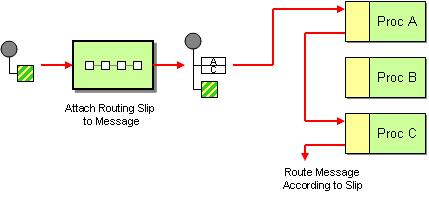...
The Routing Slip from the EIP patterns allows you to route a message consecutively through a series of processing steps where the sequence of steps is not known at design time and can vary for each message.

Options
| Div |
|---|
| class | confluenceTableSmall |
|---|
|
Name | Default Value | Description |
|---|
uriDelimiter | , | Delimiter used if the Expression returned multiple endpoints. | ignoreInvalidEndpoints | false | If an endpoint uri could not be resolved, should it be ignored. Otherwise Camel will throw an exception stating the endpoint uri is not valid. | cacheSize | 1000 | Camel |
|
| Wiki Markup |
|---|
| {div:class=confluenceTableSmall}
|| Name || Default Value || Description ||
| {{uriDelimiter}} | {{,}} | Delimiter used if the [Expression] returned multiple endpoints. |
| {{ignoreInvalidEndpoints}} | {{false}} | If an endpoint uri could not be resolved, should it be ignored. Otherwise Camel will throw an exception stating the endpoint uri is not valid. |
| {{cacheSize}} | {{1000}} | *Camel * {{}} |
{div} |
Example
The following route will take any messages sent to the Apache ActiveMQ queue SomeQueue and pass them into the Routing Slip pattern.
...
